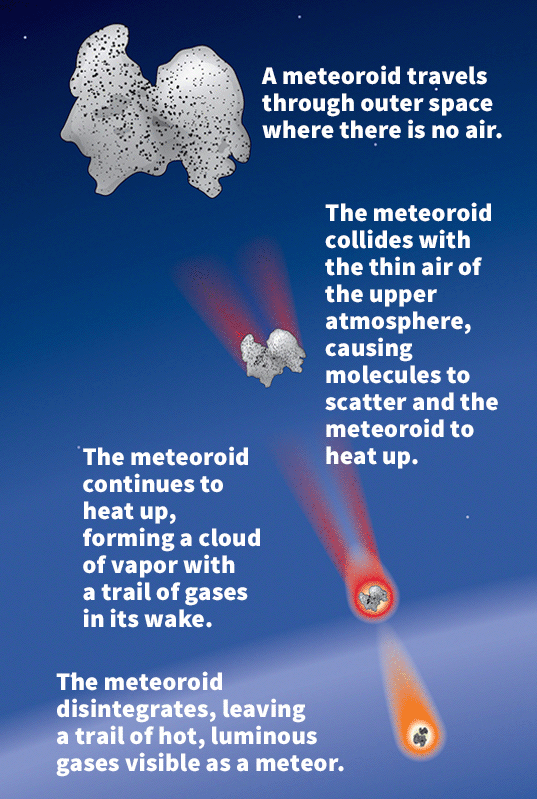May 22-28, 2014, Current Events Lesson Plan
Current Event: Sky Show Tonight?
A brand-new meteor shower called the Camelopardalids recently made its debut in Earth’s sky. The meteor shower was produced by grains of dust ejected from a small, dim comet known as 209P/LINEAR that was discovered in 2004. This comet has been orbiting between Jupiter and the sun about every five years since at least 1703, but this was the comet’s first chance to strut its shooting-star stuff. The reason is that Jupiter has been slowly altering the comet’s orbit, and so this was the first time that Earth sped through the comet’s dusty tail. Astronomers were unsure about how dazzling the meteor shower might be, with some sources suggesting up to 1,000 meteors per hour. Unfortunately, the Camelopardalids were a disappointment. In many places, skywatchers saw only 5 to 10 meteors per hour. Many observers saw none.

A meteor appears in the sky when an object called a meteoroid enters the atmosphere from space. (World Book illustration by Greg Maxson)
Objective:
Meteors are streaks of light that appear in the sky. A meteor appears when a piece of matter enters Earth’s atmosphere from space at high speed. Such a piece of matter is called a meteoroid. Most meteoroids that cause visible meteors are smaller than a pebble. As the meteoroid collides with the air, it is heated so that it glows, creating a shining trail of hot gases. Most meteoroids break apart in a second or less. A meteor shower occurs when Earth travels through a stream of meteoroids. The rate at which meteors appear generally increases, peaks, and then decreases as Earth moves in and then out of a stream. The Behind the Headlines news story and related World Book articles explore meteors and other astronomical topics.
Words to know:
Discussion Topics:
1. Ask your students the difference between the terms meteoroid, meteor, and meteorite. (A meteoroid is a small body, often from a comet, that travels through space and becomes a meteor or shooting star when it enters Earth’s atmosphere and vaporizes. A meteorite is a meteoroid that reaches Earth’s surface intact.)
2. A meteoroid is a celestial body that orbits the sun. Ask your students if they know any other types of celestial bodies that orbit the sun. (They might say the eight planets; five recognized dwarf planets, including Pluto; comets, such as Halley’s Comet; asteroids.)
3. The comet that caused the recent meteor shower has been orbiting between Jupiter and the sun since at least 1703. Ask your students to name people who lived in the 18th century. (Students might say Johann Bach, Benjamin Banneker, Daniel Boone, Catherine the Great, James Cook, Benjamin Franklin, Thomas Jefferson, Marie Antoinette, Wolfgang Mozart, Napoleon I, Sir Isaac Newton, Voltaire, George Washington.)
4. Astronomy is the study of the universe and the objects in it. Have your students debate the topic, “It is important to study astronomy.”
5. Ask your students to use World Book’s Timelines feature to view or add to the Advances in Astronomy timeline. (Students may wish to also refer to World Book’s Astronomy article for help.)


